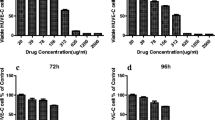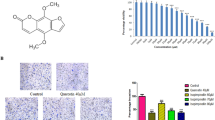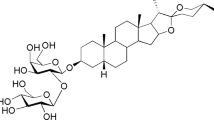Abstract
p21-activated kinase 1 (Pak1)—a key node protein kinase regulating various cellular process including angiogenesis—has been recognised to be a therapeutic target for multitude of diseases, and hence, various small molecule inhibitors targeting its activity have been tested. However, the direct toxic and anti-angiogenic effects of these pharmacologic agents have not been examined. In this study, we evaluate the translational efficacy of Pak1 inhibitor IPA-3 using zebrafish toxicity model system to stratify its anti-angiogenic potential and off-target effects to streamline the compound for further therapeutic usage. The morphometric analysis has shown explicit delay in hatching, tail bending, pericardial sac oedema and abnormal angiogenesis. We provide novel evidence that Pak1 inhibitor could act as anti-angiogenic agents by impeding the development of sub-intestinal vessel (SIV) and intersegmental vessels (ISVs) by suppressing the expression of vascular endothelial growth factor (VEGF), VEGF receptor 2 (VEGFR2), neurophilin 1 (NRP1) and its downstream genes matrix metalloproteinase (MMP)-2 and MMP-9. Knockdown studies using 2-O-methylated oligoribonucleotides targeting Pak1 also revealed similar phenotypes with inhibition of angiogenesis accompanied with deregulation of major angiogenic factor and cardiac-specific genes. Taken together, our findings indicate that Pak1 signalling facilitates enhanced angiogenesis and also advocated the design and use of small molecule inhibitors of Pak1 as potent anti-angiogenic agents and suggest their utility in combinatorial therapeutic approaches targeting anomalous angiogenesis.








Similar content being viewed by others
References
Belleri M, Ribatti D, Nicoli S, et al. Antiangiogenic and vascular-targeting activity of the microtubule-destabilizing trans-resveratrol derivative 3,5,4'-trimethoxystilbene. Mol Pharmacol. 2005;67(5):1451–9.
Brand M, Granato M, Nüsslein-Volhard C. Keeping and raising zebrafish. In: Nüsslein-Volhard C, Dahm R, editors. Zebrafish: a practical approach. Oxford: Oxford University Press; 2002. p. 7–37.
Carmeliet P, Jain RK. Angiogenesis in cancer and other diseases. Nature. 2000;407(6801):249–57.
Chimote G, Sreenivasan J, Pawar N, Subramanian J, Sivaramakrishnan H, Sharma S. Comparison of effects of anti-angiogenic agents in the zebrafish efficacy-toxicity model for translational anti-angiogenic drug discovery. Drug Des Dev Ther. 2014;8:1107–23.
Cross LM, Cook MA, Lin S, Chen JN, Rubinstein AL. Rapid analysis of angiogenesis drugs in a live fluorescent zebrafish assay. Arterioscler Thromb Vasc Biol. 2003;23(5):911–2.
Deacon SW, Beeser A, Fukui JA, et al. An isoform-selective, small-molecule inhibitor targets the autoregulatory mechanism of p21-activated kinase. Chem Biol. 2008;15(4):322–31.
Ebos JM, Lee CR, Cruz-Munoz W, Bjarnason GA, Christensen JG, Kerbel RS. Accelerated metastasis after short-term treatment with a potent inhibitor of tumor angiogenesis. Cancer Cell. 2009;15(3):232–9.
Folkman J. Tumor angiogenesis: therapeutic implications. N Engl J Med. 1971;285(21):1182–6.
Fraysse B, Mons R, Garric J. Development of a zebrafish 4-day embryo-larval bioassay to assess toxicity of chemicals. Ecotoxicol Environ Saf. 2006;63(2):253–67.
Hinoki A, Kimura K, Higuchi S, et al. p21-activated kinase 1 participates in vascular remodeling in vitro and in vivo. Hypertension. 2010;55(1):161–5.
Huynh N, He H. p21-activated kinase family: promising new drug targets. Res Rep Biochem. 2015;5:119–28.
Isogai S, Horiguchi M, Weinstein BM. The vascular anatomy of the developing zebrafish: an atlas of embryonic and early larval development. Dev Biol. 2001;230(2):278–301.
Jagadeeshan S, Subramanian A, Tentu S, et al. P21-activated kinase 1 (Pak1) signaling influences therapeutic outcome in pancreatic cancer. Ann Oncol. 2016;27(8):1546–56.
Kamei M, Saunders WB, Bayless KJ, Dye L, Davis GE, Weinstein BM. Endothelial tubes assemble from intracellular vacuoles in vivo. Nature. 2006;442(7101):453–6.
Kelly ML, Astsaturov A, Rhodes J, Chernoff J. A Pak1/Erk signaling module acts through Gata6 to regulate cardiovascular development in zebrafish. Dev Cell. 2014;29(3):350–9.
Kichina JV, Goc A, Al-Husein B, Somanath PR, Kandel ES. PAK1 as a therapeutic target. Expert Opin Ther Targets. 2010;14(7):703–25.
Kim KH, Antkiewicz DS, Yan L, et al. Lrrc10 is required for early heart development and function in zebrafish. Dev Biol. 2007;308(2):494–506.
Liang D, Chang JR, Chin AJ, et al. The role of vascular endothelial growth factor (VEGF) in vasculogenesis, angiogenesis, and hematopoiesis in zebrafish development. Mech Dev. 2001;108(1–2):29–43.
Lightcap CM, Kari G, Arias-Romero LE, Chernoff J, Rodeck U, Williams JC. Interaction with LC8 is required for Pak1 nuclear import and is indispensable for zebrafish development. PLoS One. 2009;4(6), e6025.
Lin CC, Hui MN, Cheng SH. Toxicity and cardiac effects of carbaryl in early developing zebrafish (Danio rerio) embryos. Toxicol Appl Pharmacol. 2007;222(2):159–68.
Liu CL, Kwok HF, Cheng L, et al. Molecular mechanisms of angiogenesis effect of active sub-fraction from root of Rehmannia glutinosa by zebrafish sprout angiogenesis-guided fractionation. J Ethnopharmacol. 2014;151(1):565–75.
Lyons MS, Bell B, Stainier D, Peters KG. Isolation of the zebrafish homologues for the tie-1 and tie-2 endothelium-specific receptor tyrosine kinases. Dev Dyn. 1998;212(1):133–40.
OECD (Organization for Economic Cooperation and Development). Fish Embryo Toxicity (FET) Test. OECD draft proposal for a new guideline (1st version). Guideline for the testing of chemicals, Paris; 2006. http://www.oecd.org/env/ehs/testing/36817070.pdf
Schuermann A, Helker CS, Herzog W. Angiogenesis in zebrafish. Semin Cell Dev Biol. 2014;31:106–14.
Serbedzija GN, Flynn E, Willett CE. Zebrafish angiogenesis: a new model for drug screening. Angiogenesis. 1999;3(4):353–9.
Stockton R, Reutershan J, Scott D, Sanders J, Ley K, Schwartz MA. Induction of vascular permeability: beta PIX and GIT1 scaffold the activation of extracellular signal-regulated kinase by PAK. Mol Biol Cell. 2007;18(6):2346–55.
Tobia C, Gariano G, Guerra J, Presta M. Zebrafish embryo intersegmental vessels: a tool for investigating sprouting angiogenesis. Methods Mol Biol. 2015;1214:173–84.
Westerfield M. The zebrafish book: a guide for the laboratory use of zebrafish (Brachydanio rerio). 3rd ed. Eugene: University of Oregon Press, Institute of Neuroscience; 2000.
Wong LL, Lam IP, Wong TY, et al. IPA-3 inhibits the growth of liver cancer cells by suppressing PAK1 and NF-kB activation. PLoS One. 2013;8(7), e68843.
Yan J, Manaenko A, Chen S, et al. Role of SCH79797 in maintaining vascular integrity in rat model of subarachnoid hemorrhage. Stroke. 2013;44(5):1410–7.
Yeh JC, Cindrova-Davies T, Belleri M, et al. The natural compound n-butylidenephthalide derived from the volatile oil of Radix Angelica sinensis inhibits angiogenesis in vitro and in vivo. Angiogenesis. 2011;14(2):187–97.
Zou J, Li WQ, Li Q, et al. Two functional microRNA-126s repress a novel target gene p21-activated kinase 1 to regulate vascular integrity in zebrafish. Circ Res. 2011;108(2):201–9.
Acknowledgments
We thank Dr. Sridhar Sivasubbu, IGIB for his kind support and advice. We also thank Samatha Mathew and Paras Sehgal, IGIB for their technical help to this work. The authors acknowledge the senior research fellowship (File No. 9/115(0774)/2014 EMR-I) by Council of Industrial and Scientific Research (CSIR), Government of India provided to SJ.
Author information
Authors and Affiliations
Corresponding author
Ethics declarations
Conflict of interest
The authors declare no conflicts of interest. The authors alone are responsible for the content and writing of this paper.
Electronic supplementary material
Below is the link to the electronic supplementary material.
Figure S1
Representative image showing pericardial oedema and linear heart tube with increasing concentration of IPA-3. (PPTX 6349 kb)
Figure S2: A- Real time PCR analysis of Pak1, Pak2 and Vegf gene in control-2OMe, Pak1-2OMe and Pak2-2OMe (0.25 mM) injected embryos. B- Representative images of Pak2-OMe injected embryos with cranial haemorrhage. Graph showing percentage of survived embryos with cranial haemorrhage. Graph showing C-survival rate, percentage of embryos D- with pericardial oedema and E- with defective heart.
Rights and permissions
About this article
Cite this article
Jagadeeshan, S., Sagayaraj, R.V., Paneerselvan, N. et al. Toxicity and anti-angiogenicity evaluation of Pak1 inhibitor IPA-3 using zebrafish embryo model. Cell Biol Toxicol 33, 41–56 (2017). https://doi.org/10.1007/s10565-016-9358-5
Received:
Accepted:
Published:
Issue Date:
DOI: https://doi.org/10.1007/s10565-016-9358-5




